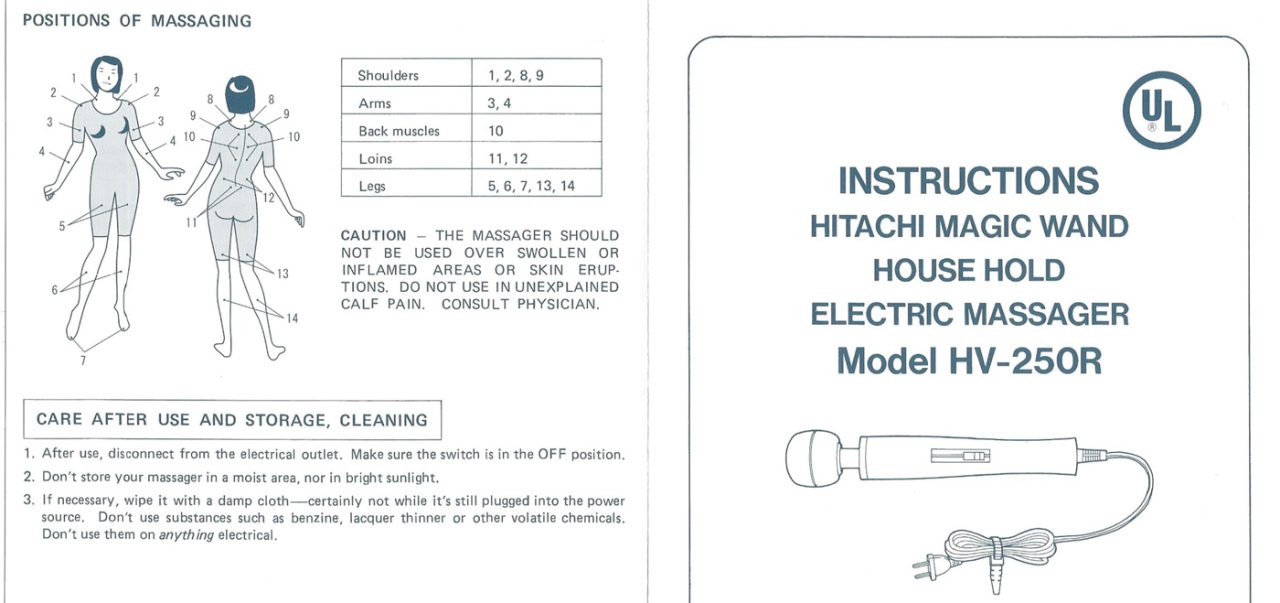From personal massager to possibly the most iconic sex toy, the wand is well-known for its multi-purpose uses, its powerful motor and its controversial history.
It’s been hailed by the likes of Sex and the City’s sex goddess Samantha Jones, who was featured with a wand sporting a G-spot attachment in the early 2000s. More recently it was refashioned by non-binary singer Demi Lovato, in collaboration with porn-for-women site Bellesa, with the mini-sized Demi-Wand.

For clarity, the ‘wand’ is a type of sex toy that is typically recognizable from its large handle and round vibrating spongy head that is used to massage “the body”. The original, now infamous, Magic Wand was designed and patented by Hitachi, but others have since launched their own versions of wands.
Available in many sizes, styles, colors, and with a variety of attachments, the wand is a timeless classic. Here we will look at its complicated history, cultural impact, and the all-important tech behind this vibrator’s popularity.

The Wand’s Complicated History
In the 1960s, Japanese tech company Hitachi launched a personal “massage wand”. Emphasis on massage, and no mention of sex. The company filed to trademark “Magic Wand” in 1968 to relieve muscular pain—and was even registered under the FDA as a recommended therapeutical electric massager—but little did Hitachi know that this device would soon become the most iconic sex toy.
How did it get to that point? Like any household appliance that vibrates, it’s not hard to imagine how creative bored housewives may have used the original “massage wand”.
Adverts for electric massagers, tracing back to the early 1900s, suggested ‘at-home’ use, marketing the products as tools for massaging tension away. One of these electric massagers, called Bebout, was suggestively advertised as a ‘health and beauty’ tool: “gentle, soothing, refreshing, and invigorating. Invented by a woman who knows a woman’s needs. All nature vibrates and oscillates with life.”
In her book Buzz: A Stimulating History of the Sex Toy, Hallie Lieberman emphasises that while there was no explicit mention of masturbation in these early 20th century adverts, “it’s impossible to deny that sexual uses for vibrators weren’t known.”

So, it might have come as no shock that when the Hitachi Wand fell into the hands of renowned American sex educator Betty Dodson during the sexual revolution of the ’60s.
For over 50 years, Dodson used the wand in her renowned Bodysex workshops, which were “designed to shed body shame and pleasure anxiety”. She confirmed that “electric vibrators were sold as massage machines and I bought them in the small-appliance section of Macy’s.” In her 1974 book Liberating Masturbation, she praises the Magic Wand as her favorite sex toy for achieving orgasm. The Goop Lab Netflix series in 2020 featured Dodson’s business partner Carlin Ross using her “Rock and Roll” method with a wand.
Her favoring of the wand has been repeatedly backed up by science. One 1979 study found that the wand was the best method of achieving orgasm, and in a 2008 study the wand, combined with the Betty Dodson “method”, was found to be able to cure chronic anorgasmia (long-term inability of reaching orgasm) in 93 percent of women participants.
Female-founded sex toy stores including Good Vibrations by Joani Blank and Garden of Eden by Dell Williams, started popping up across the States in the ’70s to sell the celebrated wand.
The Wand’s Influence Today
All the while, Hitachi refused to acknowledge the sexual association with its device. In 2013, the company completely removed its name from the toy, leaving it to be known as the Magic Wand Original, as it is now. Since then Vibratex has been the only authorized US import agent of the Magic Wand massager.
Nevertheless, the Magic Wand has been an inspiration for a variety of wand-style toys, with the likes of the Doxy, Le Wand, Lelo, Svakom, We-Vibe, BodyWand, and Unbound Babes (among others) taking on its form.
While there may be no ambiguity around the purpose of these sex toys to the knowing eye, the term “massager” is still often used today by many vibrator companies, such as MysteryVibe. CEO Soumyadip Rakshit, says this is to get around ‘pleasure’ restrictions when marketing its flagship product Crescendo on sites like Amazon and Facebook, to avoid getting flagged as an adult product. The only problem here is, unsuspecting customers may buy it under the pretence it was for bodily massage (just check out the reviews from many purchasers misunderstanding the intended use).
The Wand In Action
While Crescendo may not fit the bill for general body massage, the wand shape was originally designed for that exact job.
If the greatest thing about the wand is its power and durability (in particular the Magic Wand Original), the second would probably be its versatility. The wand’s design allows for the benefit of stimulating all genitals and erogenous zones.
It is typically marketed to people with vulvas to externally stimulate the clitoris, awaken surrounding nerve endings—stimulating more blood flow, which equals more pleasure—and to deeply relax the muscle tissue in the pelvic floor. The vibrations don’t just get to the tip of the clitoris. If designed with a low frequency, they can reach the entire clitoris and erogenous erectile tissue, often known as the G-spot or G-area, creating powerful orgasms.
The wand is “fantastic for masturbation”, whether that’s mutual or solo, or during partnered sex, says Engles. “My favorite position for this toy with a partner is missionary wherein the giver is kneeling, giving the clit-owners a lot of space between your bodies to stimulate the external clitorial glans.”
For people with penises, or intersex genitals, the wand is an equally useful tool, for similar reasons. You can use it to vibrate the sensitive frenulum, to indirectly stimulate the P-spot (prostate) via the frenulum, and the balls.
It can also be used on other erogenous zones such as the inner thighs, the inner elbows, the nipples, or anywhere else that you would want massaging or stimulating.
Adding to its enduring appeal are the, now fairly common, attachments that connect directly to a wand. Instead of buying various toys for various body parts, you can attach specific masturbation sleeves and clitoral stimulators. The We-Vibe Wand for example offers a “flutter” attachment for clitoral stimulation and a penis stroker attachment.

The Wand’s Role in BDSM
In the BDSM world, wands are considered practical to use on people who are tied up. This is primarily thanks to the size and strength of the toy, meaning the handle can be easily positioned, and the head provides enough power to tease or edge someone to orgasm.
In the BDSM hacking world, people like ‘James’ from The Kinky Makers get pretty creative with their toys and tech skills. James was once modifying a chair to be used in a BDSM scene, and he wanted a simple way to keep the wand in place. He created the Chair Adaptor Ring to allow a standard Magic Wand to slip fit in from the top.
For a bit of background info, The Kinky Makers are sex tech hackers (the good kind of hackers) that do sex toy teardowns, which is a techy way to learn about the toys you’re using. They don’t recommend taking apart any toys you’d want to keep and use.
For anyone interested in tearing down their own toys, The Kinky Makers has a Discord channel for its community of hackers.

The ‘Magic’ in the Magic Wand
Like most vibrators, a magic wand uses a motor that spins an off-centre weight, which creates a vibration. What makes the original Magic Wand (and other well-made wands) unique is that this ‘off-centre’ weight lives in the spongy head of the toy, connected via a flexible shaft, while the motor remains in the main body of the wand, or handle shaft.
This separation between the motor and weight, allows the motor to be much larger and more powerful than most other vibrators, while also allowing the weight in the head to be larger and heavier. A powerful motor spins the weight, causing the flexible head of the vibrator to wobble, or vibrate. Speeding up these wobbles using the control buttons produces more intense vibrations.
The flexible shaft helps isolate the vibrations in the head, minimizing energy wastage, and preventing your hands from going numb — not a particularly enjoyable experience with some other toys.
So, the ‘magic’ in a a Magic Wand isn’t really the motor itself, it’s the separation of the large motor from the heavy spinning weight, resulting in powerful vibrations and a happy you.
In the Magic Wand Original (and now most other high-end larger wands), the vibrations can work at a lower frequency than most other sex toys, with a lot of amplitude, giving it a deep rumbling effect, which can also be sped up to create faster and more intense sensations.
Cheaper, smaller mini-massagers will likely contain its motor and weight inside the much smaller handle, meaning it can’t be tuned to a lower frequency, leaving the wand with a buzzy effect.
So, be wary when buying “travel-sized” wands if you enjoy a deeper sensation over a ‘buzzy’ one.

The Future of the Wand
Looking forwards, it’s unlikely another product will replace the wand as such a versatile and well-loved classic—its position as ‘the Little Black Dress of sex toys’ looks safe for now.
While suction toys are booming, offering an alternative sensation for clitoral pleasure, everyone will have their own favorite type of toy, and favorite version of each type.
The very fact that the Magic Wand sex toy design remains incredibly popular decades after its first introduction is likely due to its strength and versatility, resulting in a jostling marketplace of competing, but similar, designs—it’s up to you to decide which wand is yours.
Or does the wand, ultimately, choose you?
Read More: DIY: How to get started in sextech hacking // Vibrator-shaped dog toy released to distract curious canines from destroying real sex toys








Leave a Reply